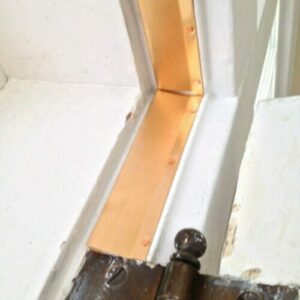While most of us love our original windows and doors, nobody wants to be heating or cooling the neighborhood due to leaks and drafts.
Before you break out the caulk gun and seal the windows shut permanently, I want to tell you about several different options to weatherstrip windows and doors.
These are all DIY friendly options that you can add to your own house. Some are quick, easy, and inexpensive, and others require more skill and money. The more work and money upfront, the less you’ll have to worry about the weatherstripping over the years, so make your decisions accordingly.
Foam Tape (Easy, $)
Self adhesive foam tape weatherstripping is available at every home store in a variety of sizes and colors. It is the easiest thing apply.
All you have to do is unroll the length you need, cut it with scissors and remove the adhesive backing. Then you simply press it in place to help fill the gaps. You can even double it up to fill larger gaps.
A helpful tip is to make sure the area has been wiped clean of dust and debris so that you get a longer life from the adhesive.
The downside to foam tape is that is compacts rather quickly, which causes it to lose its weather sealing ability after only a couple seasons. But, it’s cheap and easy to replace.
Felt (Moderate, $$)
Felt weatherstripping has been used for decades. It is very effective and can last quite a while. Like foam, it will eventually be compacted enough that it’s air sealing abilities are reduced, but it lasts much longer than foam tape.
Felt is installed a couple of different ways.The easiest is to find the self-adhesive backed felt and apply it just like the foam tape.
A longer-lasting installation involves nailing the foam in place with small weatherstrip nails. This technique can give your felt a very long life and is my preferred way to install.
Spring Bronze (Moderate, $$$)
We’ve talked about this before, but this is the grandaddy of weatherstripping. Once installed, it will never need replacement or maintenance for well over 100 yrs.
The price of bronze isn’t cheap, running about $1.25 per foot at the time of this writing. You also need bronze or copper nails to attach it. You can’t use standard nails due to the possibility of galvanize corrosion, which occurs when you put dissimilar metals in contact.
The spring bronze is installed along the window and door jambs and creates an air seal by pressure fitting against the door or window sash. It can be tuned to fit larger or smaller openings by adjusting the spring angle so it works well for a range of gaps and applications.
Learn how to install it on windows here
Learn how to install it on doors here
Don’t Forget the Bottom
The space between the bottom of your door and your threshold is an often overlooked spot for draft sealing and it’s one of the biggest.
It requires different kinds of weatherstripping called sweeps in order to keep the elements out. A properly fit door sweep will do wonders at keeping the outside out and the inside in.
Start by measuring the gap between the bottom of the door and the threshold. Some sweeps are adjustable and others have a pre-set size. You’ll also need to measure the width of your door and double check the thickness. Most exterior doors are 1 3/4″ thick, so most sweeps are made to fit that, but on an old house you may have a unique thickness to your door which will require a little more creative shopping to find the right product.
The variety of sweeps available at the home store is pretty incredible, so you shouldn’t have trouble finding one for your house.
Some are nailed in, but most sweeps easily install with just a few screws. Having a small hack saw on hand is handy for trimming the sweep to the proper length.
Picking the right weatherstripping for your home is important. It’s something I would do right away because the longer it’s installed, the more money you save.
Find what’s right for your skill level and budget and get to work one weekend soon. Not only will your house be more comfortable, but your energy bills will see welcomed dip as well.

Founder & Editor-in-Chief
I love old houses, working with my hands, and teaching others the excitment of doing it yourself! Everything is teachable if you only give it the chance.



I have a home and front door that is about 50 years old. I have bronze weatherstrippig now. But when the wind blows the door makes a loud “humming” sound and cold air comes in. I am wondering do I need to replace the weatherstripping and if so, what do you recommend? Do you have any recommendations? Should I hire a door company in the DFW area? Thanks!
I have a 1905 brick town house and the windows in the bay on the top floor are severely racked. I’ve filled gaps, as you suggested, with foam tape, but I’d like a more elegant solution.I’m in an Historic District and tearing out the old windows and replacing them with new ones that are slightly smaller would be frowned upon.
Would it be feasible to cut the top of the sashes to fit the frame, then take the cutoff and reverse it and fasten it to the bottom of the sash to make it, and the associated sash locks, line up?
I did just that! Then one one window I used a cut from a sticking door and stained to match.
Can you use spring bronze on casement windows? I have warped windows in a 1920s bungalow that leak air (and sometimes water).
I have 1950’s metal open out windows. What material type of weatherseal strip is best use on it?
I have a hopper window that’s a circle on the outside of the house but square on the inside. We can’t find a way to get a new window. So I’m thinking weather stripping. Should I treat it like a door or use felt? Thanks!
Danielle, felt would likely work well as would spring bronze possibly. It depends on the layout .
Nice tips! People who live in older homes or apartments can definitely benefit from these quick fixes. Thanks for sharing.